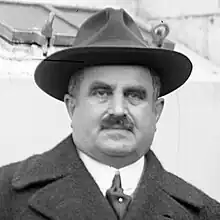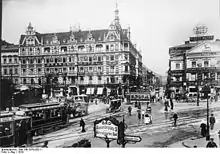Paul Davidson (producer)
Paul Davidson (30 March 1867 – 18 July 1927) was a German film producer.
Paul Davidson | |
|---|---|
 Paul Davidson | |
| Born | 30 March 1867[note 1] Lötzen, East Prussia (modern Giżycko, Poland) |
| Died | 18 July 1927 (aged 60) |
| Nationality | German |
| Occupation | film producer |
Biography
Paul Davidson was born in Lötzen, East Prussia (modern Giżycko, Poland) the son of Moritz Davidson. He initially worked as a commercial traveller in the textile industry and became the manager of a security firm in Frankfurt am Main in 1902. On vacation to Paris he saw his first movie, a Georges Méliès film, in a cinema.[1][2][3] Back in Frankfurt he founded the "Allgemeine Kinematographen-Theater Gesellschaft, Union-Theater für lebende und Tonbilder GmbH" (A.K.T.G.) on 21 March 1906 and opened Mannheim’s first permanent cinema, the Union-Theater (U.T.). Further cinemas followed in Frankfurt, Düsseldorf, Cologne, Strasbourg, Amsterdam and Brussels.[1][2]
On 4 September 1909 Davidson opened the Union-Theater at Berlin, Alexanderplatz.[4][5] Another Union-Theater was opened at Berlin's Unter den Linden on 21 August 1910, by 1910 Davidson had built up a "sizeable chain of 600–1000 seater luxury cinemas".[6] On 2 August 1913 the Union-Palast, Kurfürstendamm, one of the first buildings of Berlin exclusively built as a movie theater, premiered with Max Reinhardt’s "Die Insel der Seligen".[6][7] In March 1910 Davidson founded the Projektions-Aktiengesellschaft Union (PAGU), Germany’s first joint-stock company in film industry and the first to integrate production, distribution and equipment hire.[1]
Following the success of Asta Nielsen’s The Abyss he founded the Internationale Film-Vertriebs-Gesellschaft in conjunction with Nielsen and her husband Urban Gad on 1 June 1911.[8] The company held the European rights on all Nielsen films and Nielsen became a “scintillating international film star” with an annual fee of 85,000 Marks in 1914 alone.[1][9]

Davidson described Nielsen as the decisive factor for his move to film productions:
I had not been thinking about film production. But then I saw the first Asta Nielsen film. I realised that the age of short film was past. And above all I realised that this woman was the first artist in the medium of film. Asta Nielsen, I instantly felt could be a global success. It was International film Sales that provided Union with eight Nielsen films per year. I built her a studio in Tempelhof, and set up a big production staff around her. This woman can carry it ... Let the films cost whatever they cost. I used every available means – and devised many new ones – in order to bring the Asta Nielsen films to the world.[8][10]
In late 1912 the PAGU moved to Berlin and opened a studio in Berlin-Tempelhof (Davidson would also play an important role in the founding of the Babelsberg studios).[11] The PAGU engaged directors like Ernst Lubitsch and Paul Wegener as well as actors like Asta Nielsen, Fern Andra, Pola Negri, Ossi Oswalda, Emil Jannings and Harry Liedtke.[1]
In January 1914 PAGU was merged with Jules Greenbaum’s company to form PAGU-Vitascope, however, the project, including a cooperation with the French Pathé Freres ended at the outbreak of World War I. In August 1915 Davidson sold his cinemas to the Danish Nordisk Film.[9] [12] PAGU became part of the newfounded Universum Film AG (UFA) in 1917 and Davidson worked as the UFA’s artistic director and head of production.[12] In 1920 he left the UFA to produce Lubitsch’s "Das Weib des Pharao" (The Wife of the Pharaoh) and "Die Flamme" (The Flame) within the short-living Europäische Film-Allianz (EFA).[1][13]
When Lubitsch moved to Hollywood in 1922, Davidson had produced 39 movies directed by Lubitsch.[10][14] From 1922 he produced pictures independently, but exclusively for the UFA. He canceled his contract early in 1927 and committed suicide on 18 July that year.[1]
Selected filmography

- The Silent Mill (1914)
- The Firm Gets Married (1914)
- Ivan Koschula (1914)
- The Iron Cross (1914)
- The Tunnel (1915)
- Laugh Bajazzo (1915)
- The Dancer (1915)
- Rübezahl's Wedding (1916)
- Bogdan Stimoff (1916)
- The Yogi (1916)
- Dr. Hart's Diary (1917)
- The Ring of Giuditta Foscari (1917)
- Unusable (1917)
- Hans Trutz in the Land of Plenty (1917)
- When Four Do the Same (1917)
- The Ballet Girl (1918)
- The Toboggan Cavalier (1918)
- The Seeds of Life (1918)
- The Rosentopf Case (1918)
- Struggling Souls (1918)
- Carmen (1918)
- The Foreign Prince (1918)
- The Flyer from Goerz (1918)
- Mania (1918)
- The Pied Piper of Hamelin (1918)
- I Don't Want to Be a Man (1918)
- Madame Du Barry (1919)
- My Wife, the Movie Star (1919)
- The Howling Wolf (1919)
- The Panther Bride (1919)
- Superstition (1919)
- The Dagger of Malaya (1919)
- The Merry Husband (1919)
- The Galley Slave (1919)
- The Man of Action (1919)
- The Swabian Maiden (1919)
- Out of the Depths (1919)
- The Woman at the Crossroads (1919)
- The Doll (1919)
- Countess Doddy (1919)
- The Teahouse of the Ten Lotus Flowers (1919)
- The Oyster Princess (1919)
- The Golem: How He Came into the World (1920)
- Intrigue (1920)
- Indian Revenge (1920)
- Hundemamachen (1920)
- Sumurun (1920)
- The Last Kolczaks (1920)
- The Closed Chain (1920)
- The Love of a Thief (1920)
- Mascotte (1920)
- The Marquise of Armiani (1920)
- The Housing Shortage (1920)
- The Lady in Black (1920)
- Anna Boleyn (1920)
- Sappho (1921)
- The Maharaja's Favourite Wife (1921)
- The Eternal Struggle (1921)
- The Sins of the Mother (1921)
- Peter Voss, Thief of Millions (1921)
- The Secret of the Mummy (1921)
- The Wild Cat (1921)
- His Excellency from Madagascar (1922)
- The Game with Women (1922)
- Tabitha, Stand Up (1922)
- The Pilgrimage of Love (1923)
- Fire of Love (1925)
- The Island of Dreams (1925)
- The Little Variety Star (1926)
Notes
- Thomas Elsaesser (A second life: Germany's cinemas first decades) gives 1871 as year of birth
- The exact place of death remains unclear:
* Hans-Michael Bock (The concise Cinegraph: encyclopaedia of German cinema) gives Ebershausen
* Allgemeine Deutsche Biographie: Ebenhausen, Oberbayern
* Kay Weniger: Das große Personenlexikon des Films: Dresden on 11 June 1927
* IMDb: Berlin (IMDb biography)
References
- Bock, Hans-Michael; Bergfelder, Tim (2009). The Concise Cinegraph: Encyclopaedia of German Cinema. Berghahn books. p. 80. ISBN 978-1-57181-655-9. Retrieved 11 February 2012.
- Elsaesser, Thomas; Wedel, Michael (1996). A second life: German cinema's first decades. Amsterdam University Press. pp. 79, 80. ISBN 90-5356-183-8. Retrieved 11 February 2012.
- sztetl.org
- Grand Hotel Alexanderplatz (in German)
- Jochheim, Gernot (2006). Der Berliner Alexanderplatz (in German). Ch.Links. p. 104. ISBN 978-3-86153-391-7. Retrieved 11 February 2012.
- Elsaesser: A second life: German cinema’s first decades; page 24
- berlin.de (in German)
- Elsaesser: A second life: German cinema’s first decades; page 85
- Ingram, Susan; Sark, Katrina (2011). Berliner Chic: A Locational History of Berlin Fashion. Intellect Books. p. 119. ISBN 978-1-84150-369-1. Retrieved 11 February 2012.
- Prawer, Siegbert Salomon (2005). Between two worlds: The Jewish Presence in German and Austrian Film, 1910–1933. Berghahn books. pp. 2, 3. ISBN 1-84545-074-4. Retrieved 11 February 2012.
- biography at Allgemeine Deutsche Biographie (in German)
- Elsaesser, Thomas (2000). A second life: Weimar cinema and after: Germany's historical imaginary. Routledge. p. 112. ISBN 0-415-01234-1. Retrieved 11 February 2012.
- Kreimeier, Klaus (1999). The Ufa story: a history of Germany's greatest film company, 1918–1945. University of California Press. p. 74. ISBN 0-520-22069-2. Retrieved 11 February 2012.
- "Lubitsch joined Davidson after a brief experiment with a company of his own, and eventually made thirty-nine films for PAGU – most of them before and some after it became one of four main units that merged into Ufa", in Between two worlds: The Jewish Presence in German and Austrian Film, 1910–1933 by Prawer, 2005, in this reference list.